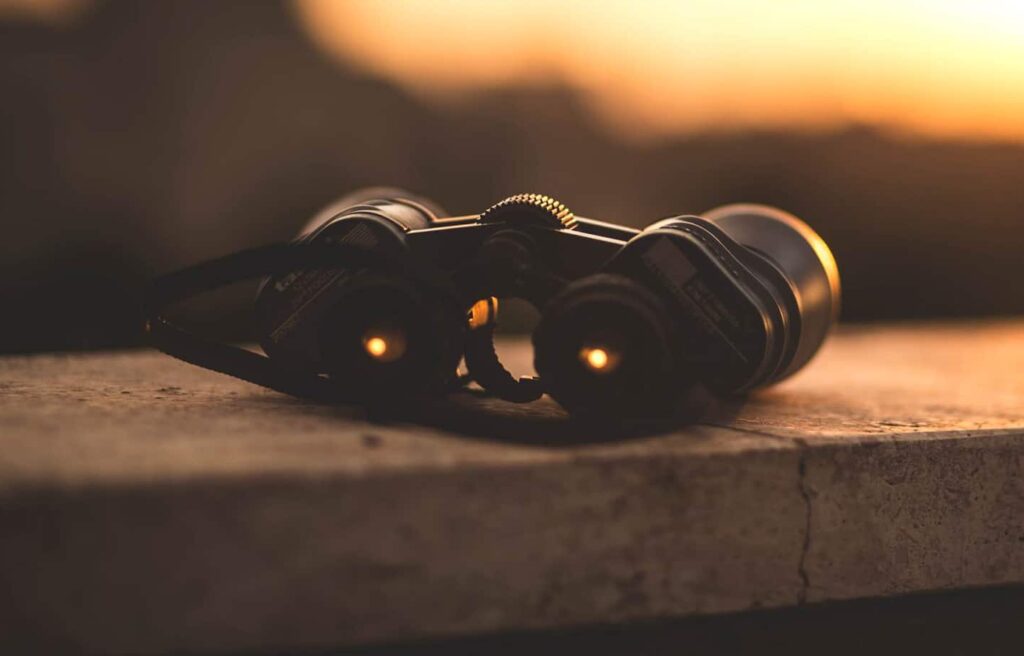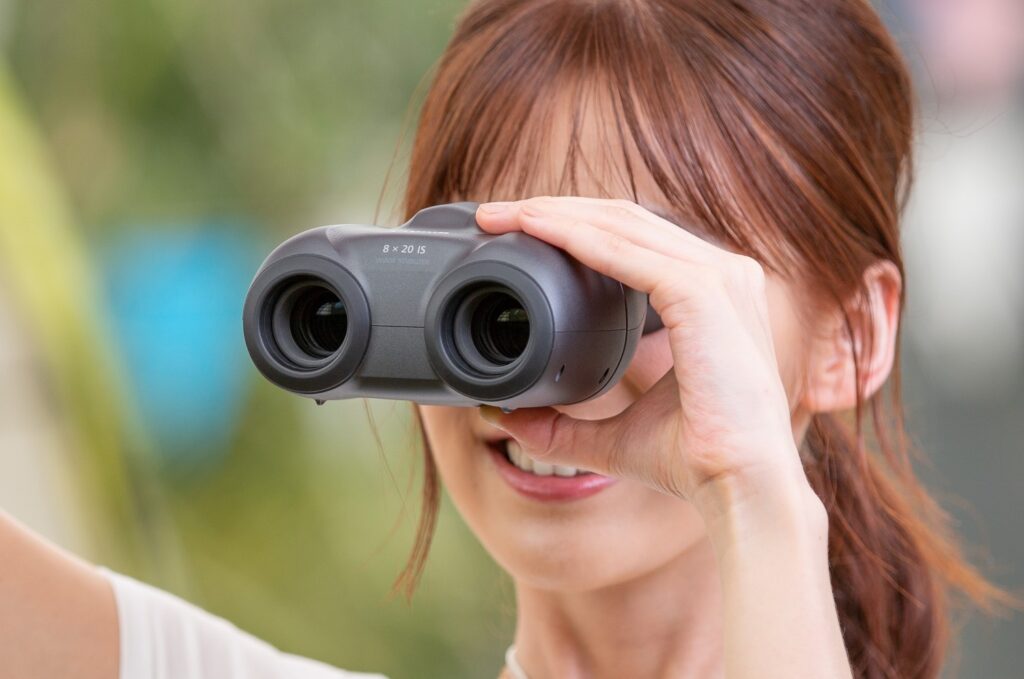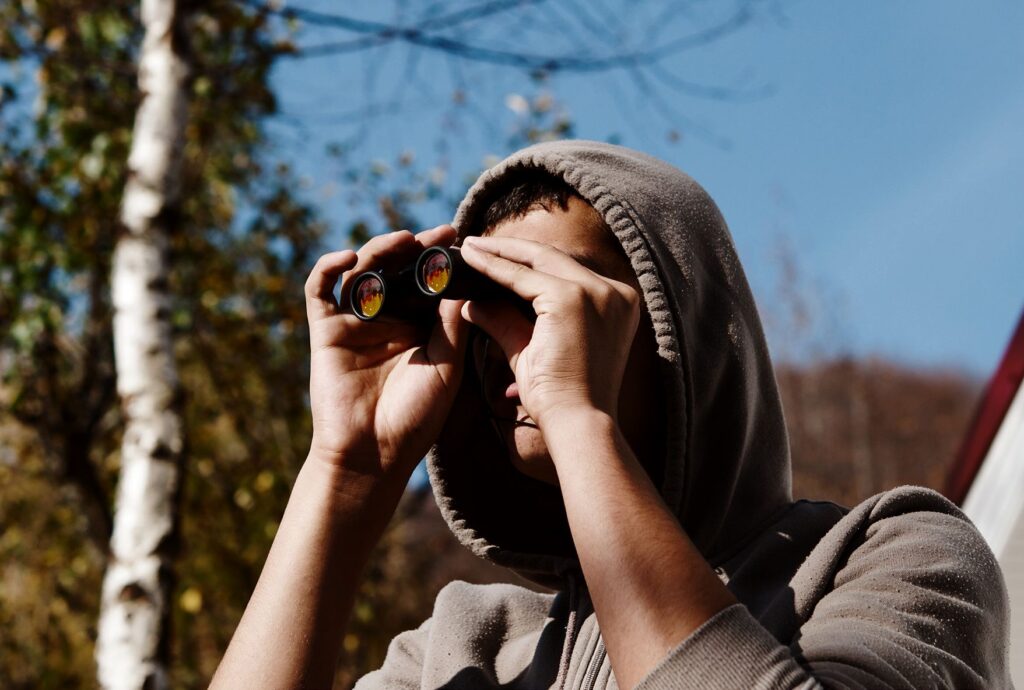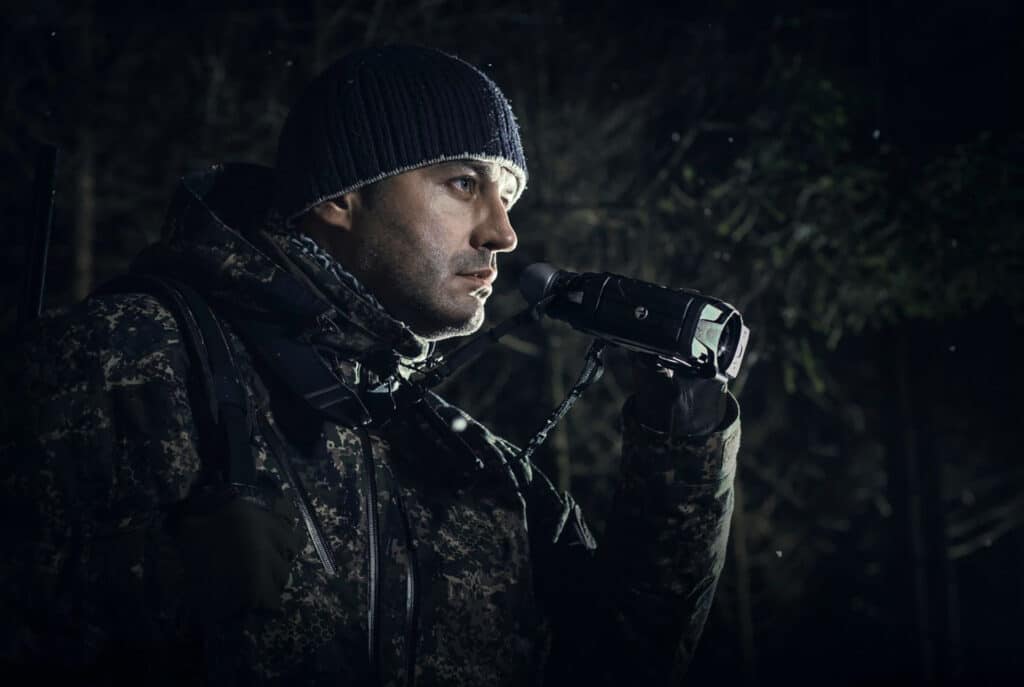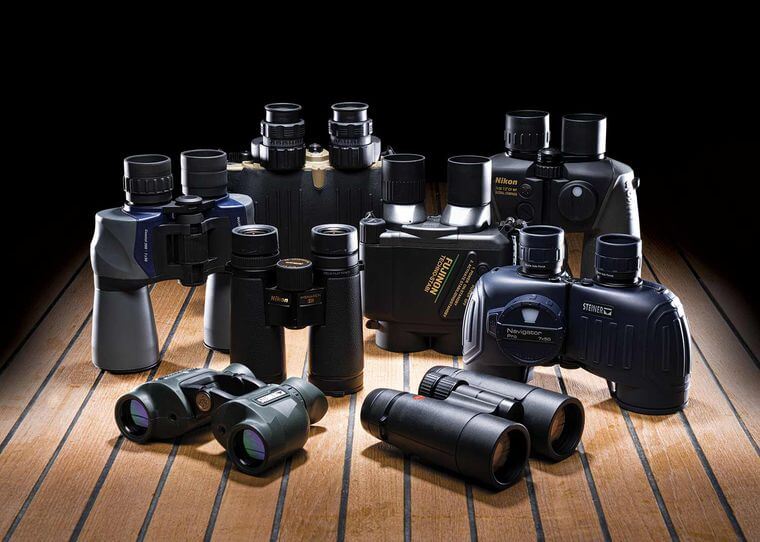

There are several reasons why you might need a pair of quality binoculars. You could have taken up hunting, hiking, or even the fun hobby of birdwatching. For all of these hobbies, decent and durable binoculars are key to fully enjoying your new hobby and providing extra clarity to your outdoor images. With so many options on the market, it can be challenging to find the best binoculars under $1000. These products have so many varying features and prices. So, where to start? Fortunately, we’ve done the leg work for you and compiled a comprehensive review of 10 of the best options to consider.
In addition to our review, we’ve drawn up a handy buying guide that highlights some of the important features to consider. Understanding features such as magnification, eye relief, and optical diameter will help you identify the best options to shortlist as a potential option. We hope you’ll continue reading as we highlight some of the better options!
More features: waterproof, tripod adaptable, high density
The Vortex Viper is a popular choice among many different outdoor enthusiasts. With this impressive model, you can expect features such as 10x magnification, a distance range of 59mm – 75mm, and a dielectric coating. Additionally, adjustable eyecups twist up and down to maximize comfortable viewing.
We chose the Viper as our editor’s choice because it’s a feature-rich product that’s guaranteed to impressive hunters, birdwatchers, and all other outdoor enthusiasts alike. Some of the more impressive features include an ArmorTek coating that keeps lenses safe from oil, dirt, and scratches. An Armor rubber adds a strong, secure, and non-slip grip. Unlike many other models on the market, the Viper boasts a locking diopter that easily adjusts for varying differences in a user’s eyes.
More features: full rubber armor, ideal contrast, great for birding, waterproof
Leica binoculars are well known for durability, excellent image performance, and great magnification of 10x. Full rubber armor keeps it safe and provides great grip. Its waterproof feature makes it ideal to use anywhere outdoors.
As our premium pick, the new and improved model comes with an ergonomic and compact design. The Leica can easily be held in one hand and guarantees precise focusing. Since this model is ideal for extreme outdoor use, it features a full rubber armor that makes this model extremely impact-resistant. You can also expect the usual lightweight and compact design.
More features: extra-low dispersion, phase-correction-coated roof prisms
Many people choose the Nikon as their absolute favorite binocular option because of its numerous features and exceptional quality. Some of these include a wide field of view, dielectric coating, above-average distance range, and objective lens caps that all fit snugly into a sturdy magnesium alloy body.
With the comprehensive feature list, it’s easy to see why this model and brand make it to just about every list. Other features include lead and arsenic-free glass, water and fog-proof, an impressive eye relief of 17mm, and phase-correction-coated roof prisms. Nikon binoculars are great for the sport.
In addition to being waterproof, this model features a nitrogen-filled body that makes it water-resistant up to a depth of 5m/16.4ft. For a maximum of 10 minutes.
More features: APO system, waterproof, tripod adaptable
If you spend a lot of time outdoors in rough terrain, you’ll need binoculars to match. The Vortex Razor is designed with extreme terrain use in mind. As with previous models, the Razor upholds the brand reputation of exceptional quality and optical performance.
Since the brand, in general, has a stellar reputation for its binocular products, it’s good to know that the Razor doesn’t disappoint. Some of the features to expect to include hand-selected prisms, a non-slip grip, ArmorTek coating as well as a locking diopter. The differentiating feature is the True Open Hinge which offers excellent ergonomics while at the same time decreasing the bulky feeling some other models often have.
More features: waterproof, diopter adjustment
If you’re looking for very detailed images made up of crisp colors, the Zeiss Conquest should definitely make your list. Impressive features such as a magnification of 10x, eye relief of 16mm, and a fully multi-coating make it the ideal option for any outdoor hobby.
With its ergonomic design, the Zeiss Conquest offers a firm grip, crystal clear images, and an optical diameter of 32mm, which all go a long way toward improving your hunting experience. This model offers users great magnification at long distances and long ranges, providing a very clear and detailed image. It’s also perfect for use in low-light settings.
More features: ergonomic silicone eyecups, Porro prism, high contrast, waterproof, best for hunting
The very impressive Steiner Predator AF offers several features that make this model a firm favorite among hunters. Some of these include easy-to-grip, lightweight, high contrast, waterproof, and ergonomic silicone eyecups. This model is often regarded as the best hunting binoculars under $1000.
We added this model to our list as it’s a top choice among experienced hunters. Not only does it offer bright 3D detail and depth, but the Predator AF keeps prey in perfect focus at any distance or speed. This model boasts Steiner’s unique CAT (Color Adjusted Transmission) technology that allows you to see wild animals hiding in shade and bushes. With 10x magnification, this model is best for hunting.
More features: APO system, Plasma Tech, optimized HD lens elements, waterproof
The Kaibab HD model is a firm favorite among long-distance hunters. With this model, you can expect a top-quality optical performance that’s been paired with high-magnification. Additionally, phase correction coating easily enhances resolution and contrast. Added O-rings make the Kaibab waterproof, preventing moisture and dust from damaging sensitive components. It also boasts fog-proof gas that prevents internal fogging at any temperature.
We included this impressive model in our review because of its impressive features. In addition to the few we’ve already mentioned, 56mm lenses maximize low-light performance, and multiple-position eyecups suitable for use with or without eyeglasses make the Kaibab great for beginners and experienced users alike. This model is highly regarded as the best 15×56 binoculars under $1000.
Unlike many other models, this unit features ArmorTek, which is an ultra-hard, scratch-resistant coating that keeps exterior lenses from oil, dirt, and scratches. An impressive rubber Armor provides a secure and non-slip grip making it easy to hold onto in any instance.
More features: premium extra-low dispersion, BaK-4 prisms, waterproof, durable, great for birding
The Meade binoculars are designed with advanced optics in mind and offer users an optical diameter of 56mm with an impressive eye relief of 22mm. To enhance the optic experience, you can also expect extra-low dispersion glass, fully multi-coated optics, and BAK-4 prisms with dielectric coated optics.
With these incredible optics, this model is perfect for birdwatching. Additionally, these binoculars are nitrogen purged as well as waterproof. That means they easily stay dry, dust and dirt-free, making them the ideal option for outdoor viewing. Many users view this model as one of the best birding binoculars under $1000. Another impressive feature of the Meade is the integrated field flattener lenses which eliminate all field curvature. This, in turn, yields all-around sharp and clear images.
More features: barrels are cross-reinforced for maximum structural rigidity
If you’ve decided to take your interest in the stars to the next level, then this Orion binocular is the best model for the job. There’s a reason this model has been labeled the biggest and brightest astronomy binocular. Some of the features we love include superior 25x magnification, 100mm objective lenses, 18mm eye relief, and a large aperture.
This powerful model made it to our list because of its wholesome list of features, and its overall design makes it the best option for experiencing the night sky like never before. A larger aperture, fully multi-coated optics, and a long-distance range provide a much wider field of view. With its high magnification, it’s necessary to use a tripod.
This model isn’t called a GiantView for no reason. It not only provides an optical range of 100mm with a 25x magnification but also boasts a 4mm exit pupil and an 18mm eye relief which means people wearing eyeglasses don’t have to remove their glasses to enjoy the superior view!
More features: fiberglass-reinforced, waterproof, smooth-running, and easy-access focusing, great for birding
If you’re an outdoor enthusiast with high expectations of your binoculars, then the Zeiss Terra is worth considering. Designed to be light, compact, durable, and sturdy, this model is ideal for birdwatching, sightseeing, use at the racetrack, and just about anywhere else!
We’ve added this model to our list because its outstanding features make it the ideal outdoor companion. Some of these include the top-notch coating that provides the clearest images, an easy-to-use focus wheel, waterproofing, and fiberglass-reinforced. Unlike many other binoculars on the market, this model offers ergonomically correct eyecups, which makes viewing both comfortable and easy.
When you start looking around for a pair of binoculars for your new hobby, a simple online search will quickly let you know that there are tons of options. If you’re not sure what you should be looking for, you could easily end up buying a pair that doesn’t really serve your needs.
That’s why we’ve compiled a convenient buying guide to help you identify the best features to consider when you’re creating a potential shortlist. Additionally, we’ll also look at the advantages of buying binoculars for under $1000. Use our guide to make choosing the right pair of binoculars stress-free. Read on for all the information you need!
When you’re considering which model to opt for, you might be wondering what the benefits are of choosing binoculars under $1000. Some of the advantages include:
When you start looking at potential binocular options, you should know that it’s not a “one-size-fits-all” scenario. Different features, sizes, and accessories differentiate each potential option. It’s necessary to know what you should look for to get the best out of your next purchase. Read on as we highlight the necessity of considering features such as magnification, a field of view, and optical diameter.
When you’re buying a binocular for the first time, it’s wise to select a model that’s both suited to your intended purpose as well as being user-friendly. The last thing you want to do is spoil the outdoor experience because you’re struggling to use a complex model.
If you want to do some birdwatching on the weekend, there’s no need to buy a model that’s designed for use by expert hunters, military or marine use.
To simultaneously track moving objects and minimize shaking, you’ll need a binocular with good magnification. Essentially, binoculars with a magnification of 6 to 10x are not only easy to use but also keep shaking to a minimum. This type of magnification is perfect for birdwatching and tracking moving options. The Vortex Viper HD 10×50 Binoculars have a magnification of 10x, while the Orion GiantView 25×100 Astronomy Binoculars have a much higher magnification of 25x.
Simply put, the optical diameter of your binocular lens, or lens diameter as it’s called, determines the amount of light that your binocular can gather. A larger optical diameter captures light and provides a great view even in instances of low light such as sunset or wintery days. The Leica Trinovid 10×42 HD Binoculars have an optical diameter of 42mm, which is quite common. The Vortex Kaibab HD 18×56 Binoculars, on the other hand, have an impressive diameter of 56mm.
The “field of view” (FOV) or “angle of view” “(AOV) are two ways of describing the scenery or width of the image that’s visible when you look through the binoculars.
Generally, AOV is expressed in degrees, whereas FOV is measured in feet or meters. This gives you the view at a certain distance away.
Here you want the widest field of view possible so that you can get to see more of the objects you’re looking for or at. The Nikon 10×42 Monarch HG Binoculars on our list have a field of view of angular – 6.9°; linear – 362.0 ft./1000 yd, and apparent field of view – 62.2°. On the other hand, the Meade 10×56 MasterClass Pro ED Binocular features a field of view of angular – 6.5°; linear – 341.0 ft./1000 yd, apparent field of view of – 65.0°.
People who wear glasses usually need to keep them on when looking through the binoculars. This means that you’ll need a pair of binoculars with an eyepiece that provides enough room for easy adjustment. This gives you a good amount of eye relief. The Orion GiantView 25×100 Astronomy Binoculars have an eye relief of 18.0mm, whilst the Leica Trinovid 10×42 HD Binoculars have a lesser eye relief of 15.0mm.
Essentially, the exit pupil is the way to measure the diameter of the shaft of light that flows from the eyepiece and onto your eye. The exit pupil is a crucial indicator of whether or not the binoculars will be able to perform in lower light conditions.
It’s always a good idea to check the exit pupil measurement on the specifications before making your choice.
Lenses and glass surfaces on binoculars have varying coating layers. This determines the way you see the color and quality of the images. In short, the type of coating determines the quality of light reflectivity. There are a few coating options to consider:
Fully coated: In this instance, all lenses and glass surfaces have a coating layer.
Multi-coated: Here, only one of the primary optical elements has multiple coatings with anti-reflective coatings. The Zeiss Conquest HD 10×32 Binoculars are fully multi-coated.
Dielectric coating: This refers to a high-reflectivity prism coating that easily provides high reflectivity across the whole range of visible light. By acting as a dielectric mirror, it provides much sharper color and sharper images. An example of this is the Vortex Kaibab HD 18×56 Binoculars. Vortex is generally listed as some of the best binoculars under $200.
The point of using binoculars is to see images that are further away up close. That being said, you’ll want a model that allows you to see the best possible version of the image you’re looking at. In general, the larger the aperture, the further you’ll see if you have a high enough magnification. To give you an idea of the distance range to look out for, consider the following:
The distance range of 25mm: Ideal for close-range viewing but has poor low-light performance – more suited to tourists and not good for birdwatching or hunting.
The distance range of 40 & 42mm: A good all-purpose option that’s not only lightweight but also boasts medium to high power – ideal for bird watching, hunting, hiking, and even sightseeing.
Distance of 50mm +: This option is the superior choice for low-light settings such as late afternoon hunts or astronomy – best suited for hunters and wildlife observers. A powerful example of this type of distance range is the Vortex Viper HD 10×50 Binoculars with a distance range of 59mm – 75mm.
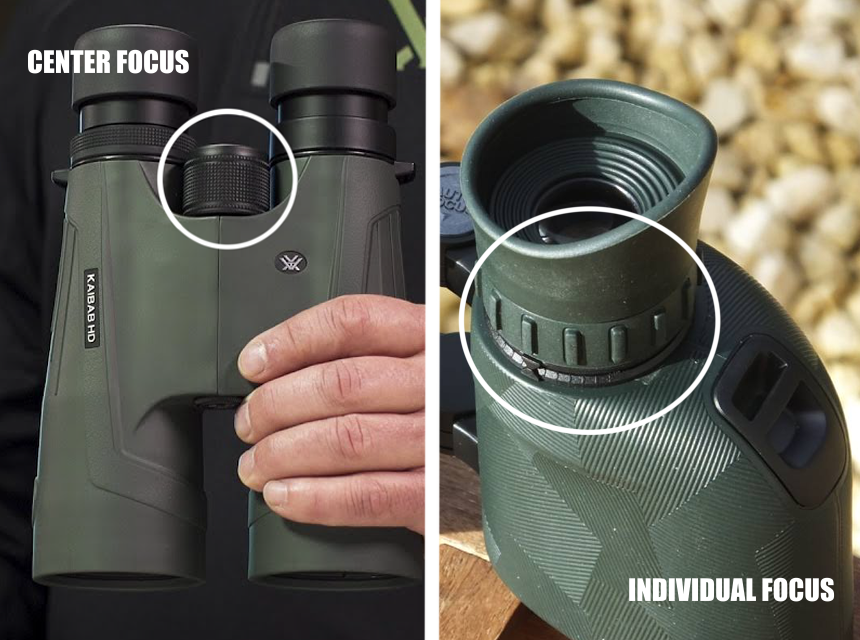
Focus usually makes the image clearer in relation to your eyesight. Essentially, you’re maximizing the benefits of an up-close sight. So, you’ll be getting sharper, crisper images. To simplify, this allows you to eliminate blurry images. There are two types of focus systems or styles. They can be defined as follows:
This is the most common focus method found in modern binoculars. In short, you’ll be adjusting the focus with a wheel or knob situated in the center of the binoculars. This adjusts both lenses simultaneously.
While it seems simple enough, we recommend reading up on this process and practicing beforehand. It can be tricky, depending on your level of experience and the binoculars you’re using. Most of the models in our review, such as the Vortex Viper HD 10×50 Binoculars boast a center focus system.
As the name implies, this type of focus system allows you to focus on each eye individually. Often called Individual Focus or IF, these binoculars are factory-set to focus for distances beyond 40 yards. This in turn gives you a fixed, wider depth of field.
Before opting for this type, it’s worth noting that they aren’t ideal for close focusing. They’re typically more suited to military and marine use. It’s important to bear in mind that they CAN NOT be set according to individual eye strengths. The only real benefit of this type of system is that reduces the need to constantly re-focus. On our product list, the Steiner Predator AF 10×42 Binoculars are listed as having an IF system, making them ideal for hunting. If you’re looking for binoculars best suited for marine use, consider reading our article about best binoculars for whale watching.
There’s no denying that you’ll want some snazzy accessories to make your binocular use more fun and effective. Some of the more prominent accessories currently used by hobbyists include the following:
A cleaning kit: This is more of a necessity than an accessory. Keeping your binoculars clean is important to increase their lifespan.
Tripod: Depending on the binoculars you have, a tripod might be mandatory or improve your experience.
Comfortable straps: Cheap nylon straps around your neck can be uncomfortable and eventual cause neck or back strain. Opting for quality straps is a good idea.
Carrying case or protective bag: Ideal, if a manufacturer doesn’t provide a quality, carry case to keep your binoculars safe.
Universal cell phone adapter mount: This allows you to take photographs through your binoculars.
Monopod for stability and portability: Often, a monopod is more helpful than a tripod. A monopod offers great stability and is ideal for birdwatching.
Strap harness for binoculars: Activities such as birdwatching, hiking, traveling, and watching wildlife will benefit from the comfort of a harness strap.
Our extensive review of the best binoculars under $1000 should make it extremely easy to choose the ideal option for your hobby. Still on the fence about which option will be the best choice? Let’s recap our top three.
The Vortex Viper HD 10×50 Binoculars is our editor’s choice and we rated it 9.9. Its amazing features include superior optics, rugged construction and better resolution. Our premium pick, the Leica Trinovid 10×42 HD Binoculars with a rating of 9.8 and made it to our top three because of it boasts an ergonomic design and durability.
Last but not least, our best value option, the Meade 10×56 MasterClass Pro ED Binocular with a rating of 9.2 is impressive because its integrated lenses make it perfect for any outdoor hobby. Combining the detailed information from our review with the top features from our nifty buying guide will make it much easier to choose the best binoculars under $1000 for your new hobby!

